
Ossian is the narrator and purported author of a cycle of epic poems published by the Scottish poet James Macpherson, originally as Fingal (1761) and Temora (1763), and later combined under the title The Poems of Ossian. Macpherson claimed to have collected word-of-mouth material in Scottish Gaelic, said to be from ancient sources, and that the work was his translation of that material. Ossian is based on Oisín, son of Fionn mac Cumhaill, a legendary bard in Irish mythology. Contemporary critics were divided in their view of the work's authenticity, but the current consensus is that Macpherson largely composed the poems himself, drawing in part on traditional Gaelic poetry he had collected.
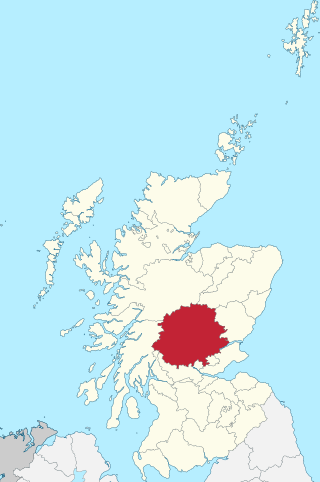
Perthshire, officially the County of Perth, is a historic county and registration county in central Scotland. Geographically it extends from Strathmore in the east, to the Pass of Drumochter in the north, Rannoch Moor and Ben Lui in the west, and Aberfoyle in the south; it borders the counties of Inverness-shire and Aberdeenshire to the north, Angus to the east, Fife, Kinross-shire, Clackmannanshire, Stirlingshire and Dunbartonshire to the south and Argyllshire to the west. It was a local government county from 1890 to 1930.

Callander is a small town in the council area of Stirling, Scotland, situated on the River Teith. The town is located in the historic county of Perthshire and is a popular tourist stop to and from the Highlands.
Hermitage, The Hermitage or L'Hermitage may refer to:

Blair Castle stands in its grounds near the village of Blair Atholl in Perthshire in Scotland. It is the ancestral home of the Clan Murray, and was historically the seat of their chief, the Duke of Atholl, though the current (12th) Duke, Bruce Murray, lives in South Africa. The castle stands in Glen Garry, and commands a strategic position on the main route through the central Scottish Highlands.

Kellie Castle is a castle just outside Arncroach and below the dominant hill in the area, Kellie Law. it is about 4 kilometres north of Pittenweem in the East Neuk of Fife, Scotland.

Dunkeld is a town in Perth and Kinross, Scotland. The location of a historic cathedral, it lies on the north bank of the River Tay, opposite Birnam. Dunkeld lies close to the geological Highland Boundary Fault, and is frequently described as the "Gateway to the Highlands" due to its position on the main road and rail lines north. Dunkeld has a railway station, Dunkeld & Birnam, on the Highland Main Line, and is about 25 kilometres north of Perth on what is now the A9 road. The main road formerly ran through the town, however following modernisation of this road it now passes to the west of Dunkeld.

Dyrham Park is a baroque English country house in an ancient deer park near the village of Dyrham in South Gloucestershire, England. The house, with the attached orangery and stable block is a Grade I listed building, while the park is Grade II* listed on the National Register of Historic Parks and Gardens.
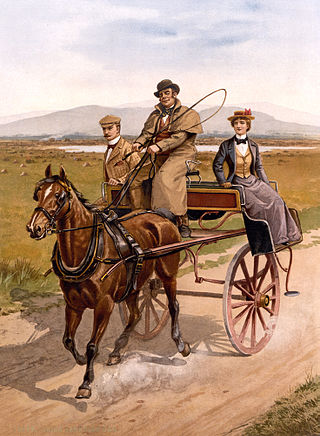
Recollections of a Tour Made in Scotland, A. D. 1803 (1874) is a travel memoir by Dorothy Wordsworth about a six-week, 663-mile journey through the Scottish Highlands from August–September 1803 with her brother William Wordsworth and mutual friend Samuel Taylor Coleridge. Some have called it "undoubtedly her masterpiece" and one of the best Scottish travel literature accounts during a period in the late 18th and early 19th centuries which saw hundreds of such examples. It is often compared as the Romantic counterpart to the better-known Enlightenment-era A Journey to the Western Islands of Scotland (1775) by Samuel Johnson written about 27 years earlier. Dorothy wrote Recollections for family and friends and never saw it published in her lifetime.


The Hermitage is a National Trust for Scotland-protected site in Dunkeld, Perth and Kinross. Located just to the west of the A9, it sits on the banks of the River Braan in Craigvinean Forest. It was created by John Murray, the third Duke of Atholl, who lived in nearby Dunkeld House, in the 18th century to honour the blind bard Ossian. It is home to the Georgian follies Ossian's Hall of Mirrors and Ossian's Cave. The hermit's cave was built around 1760 for the third Earl of Breadalbane, who unsuccessfully advertised for a permanent eremite. The guide in 1869, Donald Anderson, dressed up with a long beard of lichens and clothes of animal skins.

Rydal Hall is a large detached house on the outskirts of the village of Rydal, Cumbria, in the English Lake District. It has an early nineteenth-century front facade, but includes some earlier fabric.
Inchtavannach, is one of the larger islands in Loch Lomond.

The River Braan is a tributary of the River Tay in Scotland. Within the county of Perth and Kinross, it flows 11 miles (17 km) eastwards from Loch Freuchie, near Amulree, and joins the River Tay near Dunkeld.
The Bonnington Pavilion or Hall of Mirrors, now a ruin, is situated in the grounds of the old estate of Bonnington, near New Lanark, overlooking Corra Linn falls on the River Clyde in Lanarkshire, Scotland. Alternative names are the Corra Linn Pavilion and the Falls of Clyde summerhouse. It is said to have been the first Camera obscura built in Scotland. The name comes from the Gaelic 'currach', a marshy place. A legend gives 'Cora' as a daughter of King Malcolm II, who leapt to her death here whilst trying to escape imagined danger.

Murthly is a village in Perth and Kinross, Scotland. It lies on the south bank of the River Tay, 5 miles southeast of Dunkeld, and 9+1⁄2 miles north of Perth. Perth District Asylum, later known as Murthly Hospital, was opened in the village on 1 April 1864 for 'pauper lunatics'. It was the second district asylum to be built in Scotland under the terms of the 1857 Lunacy (Scotland) Act. It closed in 1984 and was later demolished. The village has a stone circle, in the former grounds of the hospital. The village formerly had a railway station on the Perth and Dunkeld Railway, which closed in 1965.
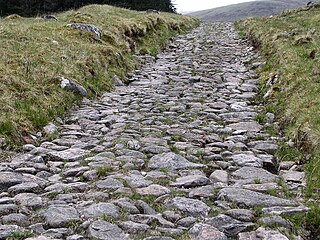
A network of military roads, sometimes called General Wade's Military Roads, was constructed in the Scottish Highlands during the middle part of the 18th century as part of an attempt by the British Government to bring order to a part of the country which had risen up in the Jacobite rebellion of 1715.
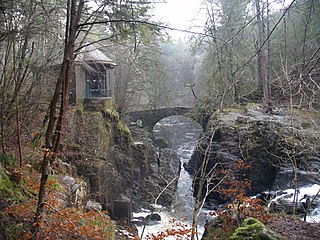
The Hermitage Bridge is an ancient, single-arch stone pedestrian bridge crossing the River Braan near Dunkeld, Perth and Kinross, Scotland. A Category A listed structure, it is in the bounds of The Hermitage, a National Trust for Scotland-protected site. The bridge should not be confused with the Rumbling Bridge, which carries motorised traffic, about 0.62 miles (1.00 km) to the southwest.
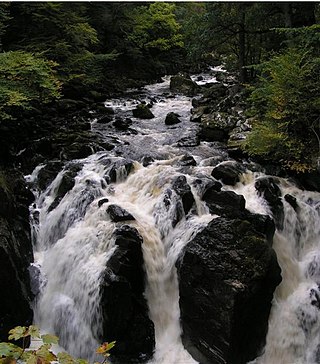
Black Linn Falls is a waterfall on the River Braan in The Hermitage, Dunkeld, Scotland. After the falls, the river passes beneath the Hermitage Bridge into a plunge pool.




















